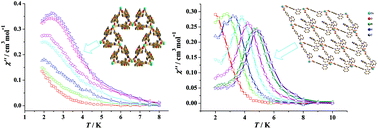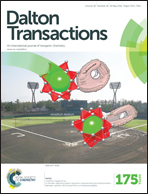3D chiral and 2D achiral cobalt(ii) compounds constructed from a 4-(benzimidazole-1-yl)benzoic ligand exhibiting field-induced single-ion-magnet-type slow magnetic relaxation†
Abstract
Organizing magnetically isolated 3d transition metal ions, which behave as single-ion magnet (SIM) units, in a coordination network is a promising approach to design novel single-molecule magnets (SMMs). Herein 3D chiral and 2D achiral cobalt(II) coordination compounds based on single metal nodes with a 4-(benzimidazole-1-yl)benzoic acid (Hbmzbc) ligand, namely, [Co(bmzbc)2(1,2-etdio)]n (1) (1,2-etdio = 1,2-ethanediol) and [Co(bmzbc)2(Hbmzbc)]n (2), have been synthesized and structurally characterized. The 3D chiral structure 1 with 2-fold interpenetrating qtz topological nets consisting of totally achiral components was obtained via spontaneous resolution, while the achiral structure 2 is a 2D (4,4) net. In both structures, individual cobalt(II) ions are spatially well separated by the long organic ligands in the well-defined networks. Magnetic measurements on 1 and 2 showed field-induced slow magnetic relaxation resulting from single-ion anisotropy of the individual Co(II) ions. Analysis of the dynamic ac susceptibilities with the Arrhenius law afforded an anisotropy energy barrier of 16.8(3) and 31.3(2) K under a 2 kOe static magnetic field for 1 and 2, respectively. The distinct coordination environments of the Co(II) ions in 1 and 2 lead to the different anisotropic energy barriers.


 Please wait while we load your content...
Please wait while we load your content...